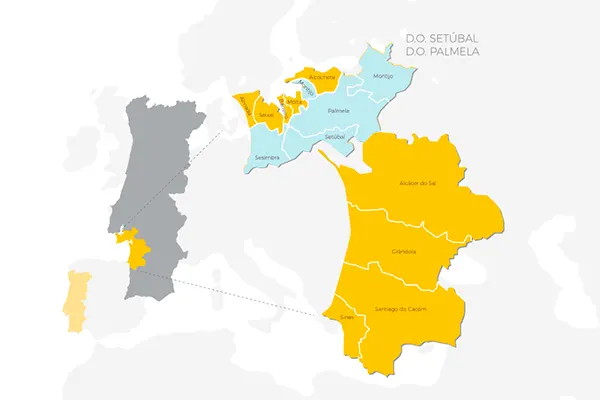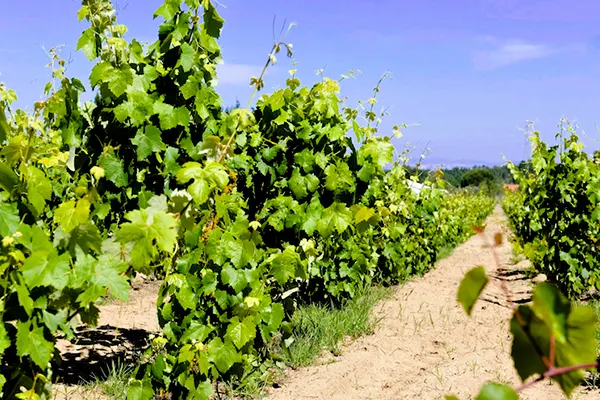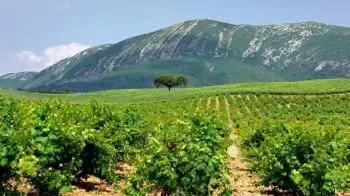The history of this region is lost in time. It was here that the first vines of the Iberian Peninsula were planted, around 2000 BC, which started a tradition that was later renewed, in 1907, with the demarcation of the Moscatel de Setúbal Region, and which survives to this day, being the second oldest demarcated region in Portugal.
It is in this region that one of the best Portuguese wines is produced: the Moscatel de Setúbal.

Image: Vinhos da Península de Setúbal
Sub-Regions of the Setúbal Peninsula
The two sub-regions of the Setúbal Peninsula are Palmela and Setúbal, best known for their DO (Denomination of Origin).
The designations of Denomination of Origin and Geographical Indication show the wines according to their origin, characteristics and grape varieties. It is this certification that guarantees the quality of the wines you will consume. In the case of the Setúbal Peninsula, wines can earn three classifications: D.O. Palmela, D.O. Setúbal, and I.G. Setúbal Peninsula (regional wine).
- D.O. Palmela: covers the municipalities of Setúbal, Palmela, Montijo and the parish of Castelo. Covers the same area as the D.O. Setúbal, but excludes the production of Moscatel de Setúbal.
- D.O. Setúbal: covers the same region as the wines produced in the D.O. Palmela, however, differs in relation to the type of wine produced, as it is fortified. In this region, only fortified wines are produced, such as Moscatel de Setúbal and Moscatel Roxo de Setúbal.
- I.G. Península de Setúbal: also called the Setúbal Peninsula Regional Wine, it covers the entire Setúbal district. This I.G. allows you to produce red and white wines with distinct personalities.

Image: ETASTE
Types of Wine and Grape Varieties of the Setúbal Peninsula Wine Region
A D.O. Palmela wine contains at least 67% of Castelão, with Aragonez, Touriga Nacional, Cabernet Sauvignon, Syrah and Trincadeira as well. They are usually very aromatic, with great aging capacity and structured.
In the D.O. Setúbal, uniquely fortified wines are produced, known as Moscatel de Setúbal and Moscatel Roxo de Setúbal, and must have a minimum of 85% of the Moscatel de Setúbal or Moscatel Roxo variety in their production.
Finally, the regional wine of the Península de Setúbal can be made from several varieties, which can be Portuguese or international. However, the most used white varieties are: Moscatel de Setúbal, Fernão Pires and Arinto. And the most used red varieties are Moscatel Roxo, Touriga Nacional, Aragonez, Syrah and Castelão.
Terroir of the Setúbal Peninsula Wine Region
This region is extensive in territory and has a Mediterranean climate, with hot and dry weather in summer, and cold and rainy weather in winter. The existence of vineyards on flat lands composed of sandy soils perfectly adapted to the production of quality grapes, as well as a more accentuated relief, results in a production of wines recognized nationally and internationally.
Pairing wines from the Setúbal Peninsula with food
The most striking characteristics of the wines from the Setúbal Peninsula are the floral aromas in the whites and the smooth flavors of spices and wild fruits in the reds. White wines are a good option to go with creamier dishes, with a cheese-based sauce, for example, or pesto sauce.
A younger Moscatel de Setúbal goes well with milk chocolate or with aromas of orange and orange blossom. An older Moscatel de Setúbal harmonizes with a darker chocolate, as this will enhance the sweetness of the wine.
When it comes to convent sweets, also only a Moscatel de Setúbal to match it, since it attenuates the flavors with its natural acidity.
 Portugal
Portugal Spain
Spain France
France Germany
Germany United Kingdom
United Kingdom Monaco
Monaco



